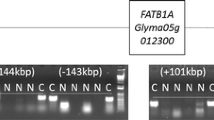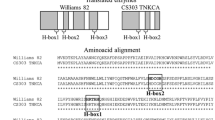Abstract
Soybean is an important crop used for oil production. Alterations of the fatty acids, especially increased oleic acid content, can improve the nutritional quality and oxidative stability of soybean oil. During seed development, two genes, encoding FAD2-1A and FAD2-1B, are mainly responsible for the transformation from oleic acid to linoleic acid, and the combination of fad2-1a and fad2-1b is the key factor for increasing oleic acid content. To breed high oleic acid varieties, we analyzed the haplotype of FAD2-1A and FAD2-1B among 1250 soybean accessions and detected a novel mutation in the FAD2-1A gene that we described as fad2-1a/W254Stop. By focusing on the mutation fad2-1a/W254Stop and the reported fad2-1b allele, we developed two molecular markers. Based on these markers, we selected one line (435) from a cross between the fad2-1a(W254Stop) allele and the existing fad2-1 allele. The oleic acid content of ‘435’ was 91.03%. The ‘435’ line was used as a donor parent, and an elite soybean cultivar ‘Heinong51’ was selected as the recurrent parent. After three backcrosses, we detected an individual with high oleic acid content (75%) and high yield. We named this individual ‘Fuhang3’. This study generated material for breeding high oleic acid soybean varieties and improved the rate of breeding novel soybean varieties.




Similar content being viewed by others
References
Amin, N.A., Ahmad, N., Wu, N., Pu, X., Ma, T., Du, Y., et al. (2019). CRISPR-Cas9 mediated targeted disruption of FAD2-2 microsomal omega-6 desaturase in soybean (Glycine max. L). BMC Biotechnology. 19, 9
Beuselinck PR, Sleper DA, Bilyeu KD (2006) An assessment of phenotype selection for linolenic acid using genetic markers. Crop Sci 46:747–750
Bhardwaj S, Passi SJ, Misra A (2011) Overview of trans fatty acids: biochemistry and health effects. Diabetes & metabolic syndrome 5:161–164
Bhat, J., Salgotra, R., Gupta, B., Kaushik, R., Kumar, B., Sharma, M., et al. (2015). Development of bacterial blight resistance versions of basmati rice genotypes from Jammu, Northern Himalaya using marker-assisted selection Indian J Biochemistry & Biophysics 52, 341–348
Bilyeu K, Skrabisova M, Allen D, Rajcan I, Palmquist DE, Gillen A et al (2018) The interaction of the soybean seed high oleic acid oil trait with other fatty acid modifications. J The American Oil Chemists Society 95:39–49
Combs R, Bilyeu K (2019) Novel alleles of FAD2-1A induce high levels of oleic acid in soybean oil. Mol Breed 39:6
Do PT, Nguyen CX, Bui HT, Tran LTN, Stacey G, Gillman JD, Zhang ZJ, Stacey MG (2019) Demonstration of highly efficient dual gRNA CRISPR/Cas9 editing of the homeologous GmFAD2-1A and GmFAD2-1B genes to yield a high oleic, low linoleic and alpha-linolenic acid phenotype in soybean. BMC Plant Biol 19:311
Dyer JM, Mullen RT (2001) Immunocytological localization of two plant fatty acid desaturases in the endoplasmic reticulum. FEBS Lett 494:44–47
Fehr WR (2007) Breeding for modified fatty acid composition in soybean. Crop Sci 47:S72–S87
Haun W, Coffman A, Clasen BM, Demorest ZL, Lowy A, Ray E, Retterath A, Stoddard T, Juillerat A, Cedrone F, Mathis L, Voytas DF, Zhang F (2014) Improved soybean oil quality by targeted mutagenesis of the fatty acid desaturase 2 gene family. Plant Biotechnology J 12:934–940
Hoshino T, Takagi Y, Anai T (2010) Novel GmFAD2-1b mutant alleles created by reverse genetics induce marked elevation of oleic acid content in soybean seeds in combination with GmFAD2-1a mutant alleles. Breed Sci 60:419–425
Howell P, Leigh F, Bates R, Gosman N, Trafford K, Powell W, Smith AM, Greenland A (2014) Rapid marker-assisted development of advanced recombinant lines from barley starch mutants. Mol Breed 33:243–248
Hudson K (2012) Soybean oil-quality variants identified by large-scale mutagenesis. Int J Agron 2012:1–7
Lakhssassi N, Zhou Z, Liu S, Colantonio V, AbuGhazaleh A, Meksem K (2017) Characterization of the FAD2 gene family in soybean reveals the limitations of gel- based tilling in genes with high copy number. Frontiers in Plant Sci 8:324
Lee J-D, Woolard M, Sleper DA, Smith JR, Pantalone VR, Nyinyi CN, Cardinal A, Shannon JG (2009) Environmental effects on oleic acid in soybean seed oil of plant introductions with elevated oleic concentration. Crop Sci 49:1762–1768
Li H, Durbin R (2009) Fast and accurate short read alignment with Burrows-Wheeler transform. Bioinformatics. 25:1754–1760
Li H, Handsaker B, Wysoker A, Fennell T, Ruan J, Homer N, Marth G, Abecasis G, Durbin R, 1000 Genome Project Data Processing Subgroup (2009) The sequence alignment/map format and SAMtools. Bioinformatics. 25:2078–2079
Lu S, Dong L, Fang C, Liu S, Kong L, Cheng Q et al (2020) Stepwise selection on homeologous PRR genes controlling flowering and maturity during soybean domestication. Nat Genet 52:1–9
Maranna S, Verma K, Talukdar A, Lal SK, Kumar A, Mukherjee K (2016) Introgression of null allele of Kunitz trypsin inhibitor through marker-assisted backcross breeding in soybean (Glycine max L. Merr.). BMC Genetics 17:106
Maroof MAS, Jeong SC, Gunduz I, Tucker DM, Buss GR, Tolin SA (2008) Pyramiding of soybean mosaic virus resistance genes by marker-assisted selection. Crop Sci 48:517–526
McKenna A, Hanna M, Banks E, Sivachenko A, Cibulskis K, Kernytsky A, Garimella K, Altshuler D, Gabriel S, Daly M, DePristo MA (2010) The Genome Analysis Toolkit: a MapReduce framework for analyzing next-generation DNA sequencing data. Genome Res 20:1297–1303
Neff MM, Turk E, Kalishman M (2002) Web-based primer design for single nucleotide polymorphism analysis. Trends Genet 18:613–615
Okuley J, Lightner J, Feldmann K, Yadav N, Lark E, Browse J (1994) Arabidopsis FAD2 gene encodes the enzyme that is essential for polyunsaturated lipid-synthesis. Plant Cell 6:147–158
Pham AT, Lee JD, Shannon JG, Bilyeu KD (2010) Mutant alleles of FAD2-1A and FAD2-1B combine to produce soybeans with the high oleic acid seed oil trait. BMC Plant Biol 10:13
Pham AT, Lee JD, Shannon J, Bilyeu K (2011) A novel FAD2-1A allele in a soybean plant introduction offers an alternate means to produce soybean seed oil with 85% oleic acidcontent. Theor Appl Genet 123:793–802
Pham AT, Shannon JG, Bilyeu KD (2012) Combinations of mutant FAD2 and FAD3 genes to produce high oleic acid and low linolenic acid soybean oil. Theor Appl Genet 125:503–515
Rajpurohit D, Kumar R, Kumar M, Paul P, Awasthi A, Basha PO et al (2011) Pyramiding of two bacterial blight resistance and a semidwarfing gene in type 3 Basmati using marker-assisted selection. Euphytica 178:111–126
Raneses AR, Glaser LK, Price JM, Duffield JA (1999) Potential biodiesel markets and their economic effects on the agricultural sector of the United States. Ind Crop Prod 9:151–162
Ribaut JM, Jiang C, Hoisington D (2002) Simulation experiments on efficiencies of gene introgression by backcrossing. Crop Sci 42:557–565
Sales-Campos H, de Souza PR, Peghini BC, da Silva JS, Cardoso CR (2013) An overview of the modulatory effects of oleic acid in health and disease. Mini-Rev Med Chem 13:201–210
Schlueter JA, Vaslenko-Sanders IF, Deshpande S, Yi J, Siegfried M, Roe BA et al (2007) The FAD2 gene family of soybean: insights into the structural and functional divergence of a paleoplyploid genome. Crop Sci 47:S14–S26
Schmutz J, Cannon SB, Schlueter J, Ma J, Mitros T, Nelson W, Hyten DL, Song Q, Thelen JJ, Cheng J, Xu D, Hellsten U, May GD, Yu Y, Sakurai T, Umezawa T, Bhattacharyya MK, Sandhu D, Valliyodan B, Lindquist E, Peto M, Grant D, Shu S, Goodstein D, Barry K, Futrell-Griggs M, Abernathy B, du J, Tian Z, Zhu L, Gill N, Joshi T, Libault M, Sethuraman A, Zhang XC, Shinozaki K, Nguyen HT, Wing RA, Cregan P, Specht J, Grimwood J, Rokhsar D, Stacey G, Shoemaker RC, Jackson SA (2010) Genome sequence of the palaeopolyploid soybean. Nature. 463:178–183
Shi Z, Bachleda N, Pham AT, Bilyeu K, Shannon G, Nguyen H, Li Z (2015) High-throughput and functional SNP detection assays for oleic and linolenic acids in soybean. Mol Breeding. 35:176
Singh VK, Singh A, Singh SP, Ellur RK, Choudhary V, Sarkel S, Singh D, Krishnan SG, Nagarajan M, Vinod KK, Singh UD, Rathore R, Prashanthi SK, Agrawal PK, Bhatt JC, Mohapatra T, Prabhu KV, Singh AK (2012) Incorporation of blast resistance into “PRR78”, an elite Basmati rice restorer line, through marker assisted backcross breeding. Field Crop Res 128:8–16
Sweeney DW, Carrero-Colon M, Hudson KA (2017) Characterization of new allelic combinations for high-oleic soybeans. Crop Sci 57:611–616
Takeshima R, Hayashi T, Zhu J, Zhao C, Xu M, Yamaguchi N, Sayama T, Ishimoto M, Kong L, Shi X, Liu B, Tian Z, Yamada T, Kong F, Abe J (2016) A soybean quantitative trait locus that promotes flowering under long days is identified as FT5a, a FLOWERING LOCUS T ortholog. J Experimental Botany 67:5247–5258
Tang GQ, Novitzky WP, Griffin HC, Huber SC, Dewey RE (2005) Oleate desaturase enzymes of soybean: evidence of regulation through differential stability and phosphorylation. Plant J 44:433–446
Thapa R, Carrero-Colon M, Crowe M, Gaskin E, Hudson K (2016) Novel FAD2-1A alleles confer an elevated oleic acid phenotype in soybean seeds. Crop Sci 56:226–231
Tyagi S, Mir RR, Kaur H, Chhuneja P, Ramesh B, Balyan HS, Gupta PK (2014) Marker-assisted pyramiding of eight QTLs/genes for seven different traits in common wheat (Triticum aestivum L.). Mol Breed 34:167–175
Varshney RK, Mohan SM, Gaur PM, Chamarthi SK, Singh VK, Srinivasan S et al (2014) Marker-assisted backcrossing to introgress resistance to fusarium wilt race 1 and ascochyta blight in C 214, an elite cultivar of chickpea. Plant Genome 7:1
Wang X, Jiang G, Green M, Scott RA, Hyten DL, Cregan PB (2014) Quantitative trait locus analysis of unsaturated fatty acids in a recombinant inbred population of soybean. Mol Breeding 33:281–296
Wang F, Wang C, Liu P, Lei C, Hao W, Gao Y et al (2016) Enhanced rice blast resistance by CRISPR/Cas9-targeted mutagenesis of the ERF transcription factor gene oSERF922. PLoS One 11:4
Zhang L, Yang X, Zhang Y, Yang J, Qi G, Guo D, Xing GJ, Yao Y, Xu WJ, Li HY, Li QY, Dong YS (2014) Changes in oleic acid content of transgenic soybeans by antisense RNA mediated posttranscriptional gene silencing. International J Genomics 2014:1–8. https://doi.org/10.1155/2014/921950
Funding
This study was funded by the National Natural Science Foundation of China (31801384), the Major Program of Guangdong Basic and Applied Research (2019B030302006), and the Strategic Action Plan for Science and Technology Innovation of the Chinese Academy of Sciences (XDA08030108).
Author information
Authors and Affiliations
Contributions
FK designed the experiments. HN, SL, CF, ZH, CY, QZ, and BL carried out the experiments. HN, SL, and FK analyzed the data. HN, SL, and FK wrote the paper.
Corresponding authors
Ethics declarations
Conflict of interest
The authors declare that they have no competing interests.
Additional information
Publisher’s note
Springer Nature remains neutral with regard to jurisdictional claims in published maps and institutional affiliations.
Rights and permissions
About this article
Cite this article
Nan, H., Lu, S., Fang, C. et al. Molecular breeding of a high oleic acid soybean line by integrating natural variations. Mol Breeding 40, 87 (2020). https://doi.org/10.1007/s11032-020-01168-y
Received:
Accepted:
Published:
DOI: https://doi.org/10.1007/s11032-020-01168-y




